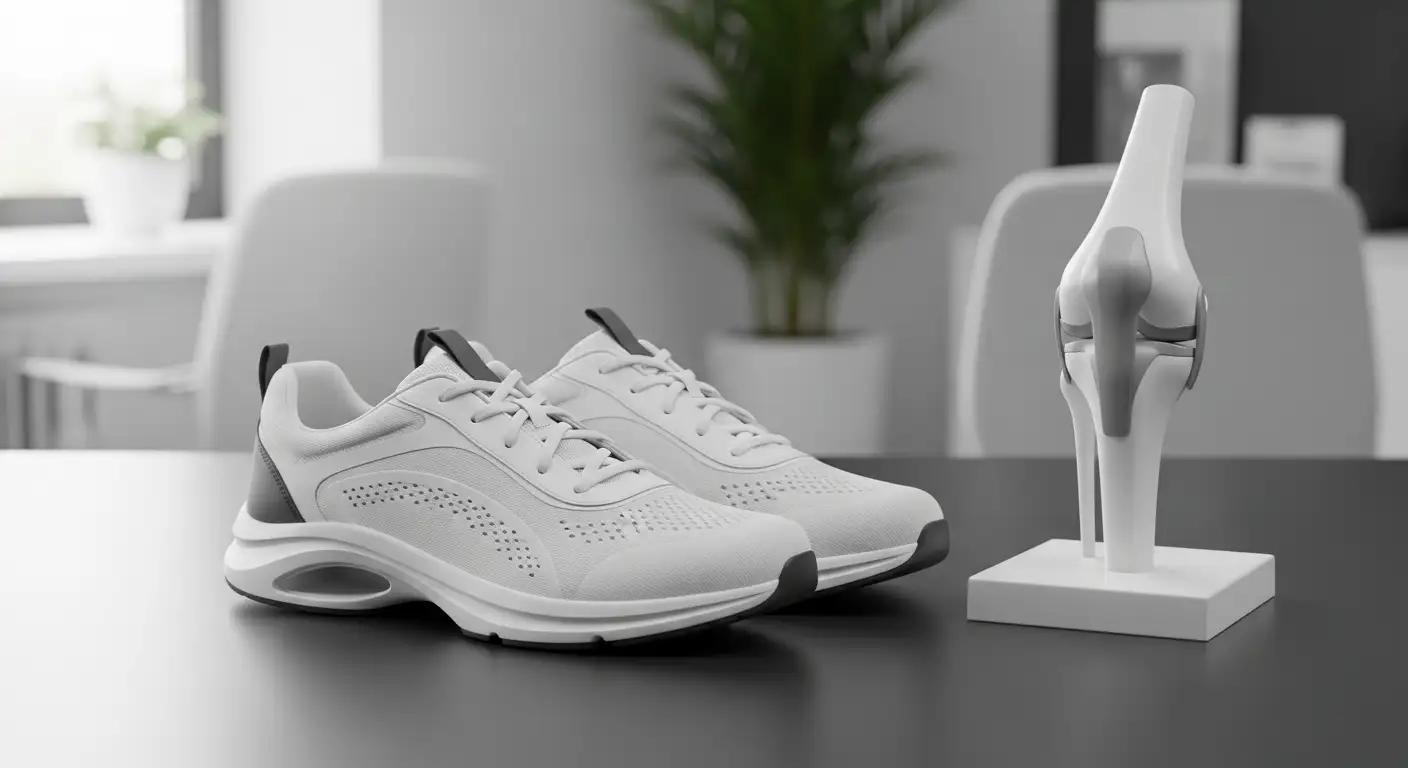Understanding Knee Swelling
Swelling in the knee is a common condition that can occur for various reasons. Let's delve into the definition, causes, symptoms, and evaluation process related to knee swelling.
Definition and Causes
Knee swelling, or "water on the knee", is caused by a buildup of fluid in or around the knee joint. This fluid accumulation can be due to traumas like sports injuries or health conditions like arthritis [1].
Swelling can be classified into two main types: traumatic or nontraumatic. Traumatic knee swelling usually results from injuries such as sports injuries, while nontraumatic knee swelling is often caused by arthritis, including degenerative arthritis (osteoarthritis) and inflammatory arthritis like rheumatoid arthritis and psoriatic arthritis.
Certain conditions like Prepatellar Bursitis and Septic Bursitis can also cause knee swelling without pain. Prepatellar Bursitis is an inflammation of the bursa in front of the kneecap, potentially caused by repeatedly kneeling for an extended period. On the other hand, Septic Bursitis is an infection in the knee that can exhibit symptoms similar to the flu, with knee swelling and pain being a late sign of this progressive condition.

Symptoms and Evaluation
The primary symptom of a swollen knee is an enlargement or puffiness around the knee area, which may or may not be accompanied by pain. Despite the term 'swollen knee no pain', discomfort can occur in some cases, especially when the swelling is due to an underlying disease or condition.
To evaluate a swollen knee, a healthcare provider will typically conduct a physical examination and ask about the patient's medical history. They may ask about the onset of the swelling, any related symptoms, and any known injuries or health conditions. The knee will be examined for signs of injury, infection, or inflammation, and the range of motion may be assessed.
Further tests, like imaging scans or fluid analysis, may be ordered to confirm the cause of the swelling. Based on the evaluation, the healthcare provider will recommend a suitable treatment plan, which may include self-care measures, over-the-counter medications, or medical interventions.
In the case of a swollen knee with no pain, it's particularly important to seek medical advice, as it can indicate an underlying condition that needs treatment. Prompt diagnosis and treatment can help prevent further complications and improve the overall prognosis.
Types of Knee Swelling
Knee swelling, even without pain, can be categorized based on the cause of the swelling. We'll explore two main categories: traumatic and nontraumatic knee swelling, and swelling due to inflammatory conditions.
Traumatic vs. Nontraumatic
Traumatic knee swelling usually results from injuries such as sports injuries, falls, or accidents. For example, injuries to the anterior cruciate ligament (ACL) or a torn meniscus can cause fluid buildup in and around the knee joint, leading to a swollen knee. Trauma to the knee's bones, ligaments, tendons, bursae, meniscus, or articular cartilage can cause swelling, warmth, stiffness, and bruising in the knee joint, a condition known as hemarthrosis, which requires urgent medical care.
On the other hand, nontraumatic knee swelling is often caused by arthritis, including degenerative arthritis (osteoarthritis), and inflammatory arthritis like rheumatoid arthritis and psoriatic arthritis. These conditions can lead to an accumulation of synovial fluid in the knee joint, resulting in swelling.
Inflammatory Conditions
Inflammatory conditions are another common cause of knee swelling. These conditions include diseases such as Reiter's syndrome, juvenile rheumatoid arthritis, rheumatoid arthritis, and infectious diseases like gonorrhea, Lyme disease, tuberculosis, and brucellosis, amongst others [5].
These conditions can lead to inflammation in the knee joint, which triggers the production of excess synovial fluid, resulting in a swollen knee. Despite the lack of pain, it's important to seek medical attention if you experience a swollen knee as it could be a sign of an underlying medical condition that requires treatment.
Common Conditions Associated with Swollen Knee
While a swollen knee may not always be accompanied by pain, it can signify underlying medical conditions that require attention. Among these common conditions are prepatellar bursitis, septic bursitis, and arthritis.
Prepatellar Bursitis
Prepatellar bursitis is a condition where inflammation occurs in the bursa located in front of the kneecap. This inflammation can cause the knee to swell, often without any accompanying pain. Prepatellar bursitis is frequently caused by repetitive kneeling for extended periods. It is important to seek medical attention if this condition is suspected, as it may require specific treatment strategies to manage the swelling and prevent further discomfort [2].
Septic Bursitis
Septic bursitis is an infection in the knee that can lead to swelling. This condition may present flu-like symptoms initially, with knee swelling and pain manifesting as the infection progresses. Septic bursitis is a serious condition that requires prompt medical attention, as it can lead to complications if left untreated [2].
Arthritis
Arthritis is a common cause of nontraumatic knee swelling. There are several types of arthritis that can affect the knee, including degenerative arthritis (also known as osteoarthritis) and inflammatory types like rheumatoid arthritis and psoriatic arthritis. These conditions can cause the knee to swell and may result in varying levels of discomfort, from mild to severe. Depending on the type and severity of arthritis, different treatment strategies, including over-the-counter pain medications like NSAIDs (nonsteroidal anti-inflammatory drugs) or acetaminophen, may be recommended to help relieve pain and reduce inflammation.
In conclusion, if one notices a swollen knee without pain, it's crucial to not dismiss it as harmless. The absence of pain doesn't necessarily indicate the absence of a potential health issue. Conditions such as prepatellar bursitis, septic bursitis, and arthritis can all result in a painless swollen knee. Therefore, seeking medical advice is always recommended to ensure a proper diagnosis and treatment plan.
Treatment Options for Swollen Knee
When it comes to managing a swollen knee with no pain, the treatment options range from self-care measures to medical interventions. The most effective treatment approach will depend on the underlying cause, severity, and individual medical history.
Self-Care Measures
For a knee that's swollen but not painful, self-care measures can be an effective first line of treatment. Depending on the underlying condition, the R.I.C.E. formula (rest, ice, compression, and elevation) may be recommended.
Self-care also involves preparing for medical appointments, being referred to a specialist if needed, and actively engaging in discussions with healthcare providers regarding the condition.
Medical Interventions
In cases where self-care measures are not enough, medical interventions may be necessary. Over-the-counter pain medications like NSAIDs (nonsteroidal anti-inflammatory drugs) or acetaminophen can be used to relieve pain and reduce inflammation in the case of nontraumatic knee swelling.
Physical therapy exercises and knee braces may also be recommended to help manage the condition, depending on the cause and severity [6].
Surgery for knee swelling is typically not required; however, in cases where the swelling stems from an injury like a torn ligament or meniscus tear, knee arthroscopy may be needed. For those with arthritis with severe symptoms like swelling and pain, a knee replacement (arthroplasty) might be suggested if other treatments are ineffective.
Remember, it's essential to consult with a healthcare provider before starting any treatment plan for a swollen knee. They can provide an accurate diagnosis, guide the treatment plan, and monitor progress.
Diagnosis of Swollen Knee
Detecting the cause of a swollen knee, particularly when there is no pain, involves a comprehensive approach that includes a physical examination and various diagnostic tests.
Physical Examination
The first step in diagnosing a swollen knee involves a detailed history and physical examination, as guided by healthcare providers. During this stage, providers will take note of any visible swelling, redness, or warmth around the knee, as well as assess the patient's range of motion. They may also ask about any recent injuries, existing health conditions, or activities that may have led to the knee swelling.
Diagnostic Tests
After the physical examination, various diagnostic tests may be employed to identify the cause of the swelling. These may include:
Imaging Tests
Imaging tests, such as X-rays, are often used to assess the knee structure and pinpoint the location of the problem. In an acute injury, the appropriate radiographic series to assess a swollen knee include the anteroposterior (AP), lateral, and axial patellar images. Oblique views may be necessary to assess for tibial plateau fractures. Standing AP views are useful to assess compartment space narrowing associated with a chronic meniscal tear or osteoarthritis-overuse syndromes.
Arthrocentesis
Arthrocentesis, or joint aspiration, is a procedure where fluid is removed from the knee for analysis. This can be a useful diagnostic tool and a therapeutic procedure for knee effusion. The fluid obtained from arthrocentesis should be sent for analysis including cell count, determination of glucose and protein levels, Gram stain, bacterial culture, and special tests such as crystal analysis [5].
These diagnostic methods can help healthcare providers determine the underlying cause of knee swelling and guide appropriate treatment options. As symptoms and conditions vary, it's crucial to consult with healthcare professionals for personalized and accurate diagnosis.
Prevention and Management
While dealing with a swollen knee with no pain can be perplexing, there are clear ways to prevent and manage this condition. It involves understanding the risk factors and adopting appropriate lifestyle recommendations.
Risk Factors
Certain factors can increase the likelihood of experiencing a swollen knee. These include participation in sports activities involving sudden stops and changes in direction, such as basketball, soccer, tennis, and volleyball.
Awareness of these risk factors can help individuals take the necessary precautions to avoid knee swelling. However, it's important to note that complications can arise if a swollen knee is left unattended. For instance, if one knee becomes red and feels warm to touch compared to the other, it could be a sign of infection within the joint.
Seek medical attention if self-care measures, such as ice and rest, do not improve symptoms associated with a swollen knee.
Lifestyle Recommendations
Prevention and management of a painless swollen knee can be effectively achieved through certain lifestyle changes and routines.
- Strengthening Muscles: Incorporating exercises that strengthen the quadriceps and hamstrings can help prevent knee injuries. Weak muscles often contribute to knee injuries, and strength training can help mitigate this risk [7].
- Balance and Stability Training: Focusing on exercises that enhance balance and stability can help improve knee health and prevent swelling.
- Flexibility Exercises: Ensure to include flexibility exercises in your workouts. These exercises can help increase the range of motion in your joints and reduce the risk of injury.
- Regular Medical Check-ups: If the knee is persistently swollen or accompanied by severe pain or other serious symptoms, seek professional medical treatment. A call to a doctor or nurse can help determine if an office visit is necessary.
Preventing and managing a swollen knee involves a combination of understanding the risk factors and adhering to healthy lifestyle practices. Regular exercise, proper rest, and immediate medical attention if symptoms persist are key to maintaining good knee health.
References
[1]: https://my.clevelandclinic.org/health/symptoms/17678-swollen-knee
[2]: https://www.danalbrightmd.com/blog/what-causes-knee-swelling-without-pain-17551/
[3]: https://www.mayoclinic.org/diseases-conditions/swollen-knee/symptoms-causes/syc-20378129
[4]: https://www.arthritis-health.com/types/general/what-causes-swollen-knee-water-knee
[5]: https://www.aafp.org/pubs/afp/issues/2000/0415/p2391.html
[6]: https://www.mayoclinic.org/diseases-conditions/swollen-knee/diagnosis-treatment/drc-20378134
[7]: https://www.mayoclinic.org/diseases-conditions/knee-pain/symptoms-causes/syc-20350849
[8]: https://www.arthritis-health.com/types/general/how-care-swollen-knee





